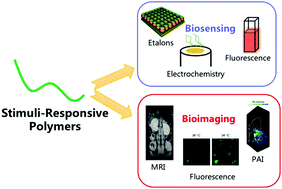Themed collection Responsive Materials for Healthcare Diagnostics

Introduction to responsive materials for healthcare diagnostics
Marek W. Urban introduces the Journal of Materials Chemistry B themed issue on responsive materials for healthcare diagnostics.

J. Mater. Chem. B, 2020,8, 6168-6169
https://doi.org/10.1039/D0TB90109A
Understanding the fate of DNA nanostructures inside the cell
DNA nanostructures are highly tunable and responsive materials for diagnostic and healthcare-related applications, but their intracellular fate remains largely unknown.

J. Mater. Chem. B, 2020,8, 6170-6178
https://doi.org/10.1039/D0TB00395F
The rise of bio-inspired polymer compartments responding to pathology-related signals
Self-organized nano- and microscale polymer compartments such as polymersomes, giant unilamellar vesicles (GUVs), polyion complex vesicles (PICsomes) and layer-by-layer (LbL) capsules have increasing potential in many sensing applications.

J. Mater. Chem. B, 2020,8, 6252-6270
https://doi.org/10.1039/D0TB00475H
Stimuli-responsive polymer-based systems for diagnostic applications
The unique properties of stimuli-responsive polymers make them valuable for myriad applications, their use for biosensing and molecular diagnostics is reviewed here.

J. Mater. Chem. B, 2020,8, 7042-7061
https://doi.org/10.1039/D0TB00570C
Microphysiological systems for the modeling of wound healing and evaluation of pro-healing therapies
Wound healing microphysiological systems have been engineered with synthetic and natural materials and techniques such as bioprinting or viscous finger patterning. Model designs focus on particular phases of wound healing or the recapitulation of micro-anatomies.

J. Mater. Chem. B, 2020,8, 7062-7075
https://doi.org/10.1039/D0TB00544D
Single plasmonic nanostructures for biomedical diagnosis
This work discusses prominent advantages and advances in single-nanoparticle characterization and synthesis, and gives an outlook on particle-based biomedical diagnosis.

J. Mater. Chem. B, 2020,8, 6197-6216
https://doi.org/10.1039/D0TB00351D
Responsive polymers for medical diagnostics
Stimulus-responsive polymers have been used in improving the efficacy of medical diagnostics through different approaches including enhancing the contrast in imaging techniques and promoting the molecular recognition in diagnostic assays.

J. Mater. Chem. B, 2020,8, 6217-6232
https://doi.org/10.1039/D0TB00366B
Design principles and fundamental understanding of biosensors for amyloid-β detection
Aβ as biomarker in Alzheimer’s disease (AD) drives the significant research efforts for developing different biosensors with different sensing strategies, materials, and mechanisms for Aβ detection.

J. Mater. Chem. B, 2020,8, 6179-6196
https://doi.org/10.1039/D0TB00344A
Smart diagnostic nano-agents for cerebral ischemia
A summary of the latest developments on imaging techniques and smart nano-diagnostics used for ischemic stroke.

J. Mater. Chem. B, 2020,8, 6233-6251
https://doi.org/10.1039/D0TB00260G
Single-molecule DNA origami aptasensors for real-time biomarker detection
DNA nanostructures as platforms to monitor the inherent conformational changes of aptamers upon analyte binding, with single-molecule resolution and real-time capability.

J. Mater. Chem. B, 2020,8, 6352-6356
https://doi.org/10.1039/D0TB01291B
Shape-transformation of polymersomes from glassy and crosslinkable ABA triblock copolymers
We used osmotic pressure changes to induce shape transformation in glassy polymersomes from crosslinkable ABA triblock copolymers. We observed that both the speed of osmotic pressure changes and order of crosslinking affect shape change behavior.

J. Mater. Chem. B, 2020,8, 8914-8924
https://doi.org/10.1039/D0TB01643H
Core–shell nanoparticles as platform technologies for paper based point-of-care devices to detect antimicrobial resistance
Development of instrument-free point-of-care devices comprising of core-shell nanoparticles as platform technology to make paper based device for detection of antimicrobial resistance in sample.

J. Mater. Chem. B, 2020,8, 6296-6306
https://doi.org/10.1039/D0TB00731E
Real-time and label-free detection of VKORC1 genes based on a magnetoelastic biosensor for warfarin therapy
This work describes the design of a magnetoelastic biosensor to detect VKORC1 genes for warfarin therapy in a fast, label-free and sensitive manner.

J. Mater. Chem. B, 2020,8, 6271-6276
https://doi.org/10.1039/D0TB00354A
Liquid crystal elastomers as substrates for 3D, robust, implantable electronics
Liquid crystal elastomers are used as substrates for robust, implantable electronics that are planar processed then morph into 3D shapes.

J. Mater. Chem. B, 2020,8, 6286-6295
https://doi.org/10.1039/D0TB00471E
Lipid-based lyotropic liquid crystalline phase transitions as a novel assay platform using birefringence as the visual signal output
Digestible amphiphilic lipids offer an opportunity to use birefringence of self-assembled lipid phases as a signal for a new class of electronics-free and colour-free visual biosensor.

J. Mater. Chem. B, 2020,8, 6277-6285
https://doi.org/10.1039/D0TB00355G
About this collection
Guest edited by Dr Gemma-Louise Davies (University College London) and Professor Marek W Urban (Clemson University).
Stimuli-responsive materials have become popular in materials chemistry in recent years, towards applications in biosensing, on-demand drug delivery, tissue generation, and smart coatings. In particular, such materials have enormous potential for medical diagnostics, for lab-on-a chip or in vivo identification and diagnosis of disease. New materials, based on inorganic complexes, organic ligands, polymers and multifunctional nanostructures, have demonstrated intriguing properties capable of changing or ‘switching’ signal in the presence of an environmental stimulus indicative of disease, providing a unique approach to positive diagnosis.
This Themed Issue in Journal of Materials Chemistry B aims to explore the latest developments in the design, preparation, novel function and application of materials for healthcare diagnostics.